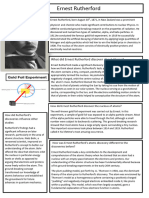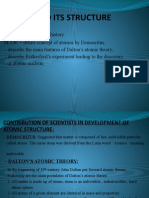0% found this document useful (0 votes)
6 views2 pagesRutherford Model
Rutherford's gold foil experiment concluded that atoms have a dense nucleus, leading to the replacement of the plum pudding model with a nuclear model. His findings indicated that most of the atom is empty space and that protons and neutrons are found in the nucleus, while electrons are randomly dispersed. A limitation of his model is that it did not explain electron orbits, which was later modified by Bohr.
Uploaded by
Juan Carlos Fajardo GómezCopyright
© © All Rights Reserved
We take content rights seriously. If you suspect this is your content, claim it here.
Available Formats
Download as TXT, PDF, TXT or read online on Scribd
0% found this document useful (0 votes)
6 views2 pagesRutherford Model
Rutherford's gold foil experiment concluded that atoms have a dense nucleus, leading to the replacement of the plum pudding model with a nuclear model. His findings indicated that most of the atom is empty space and that protons and neutrons are found in the nucleus, while electrons are randomly dispersed. A limitation of his model is that it did not explain electron orbits, which was later modified by Bohr.
Uploaded by
Juan Carlos Fajardo GómezCopyright
© © All Rights Reserved
We take content rights seriously. If you suspect this is your content, claim it here.
Available Formats
Download as TXT, PDF, TXT or read online on Scribd
/ 2
























































